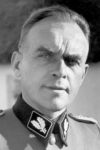German War Cemetery Belgrade
The Banovo Brdo German War Cemetery is located in Kosutnjak Park in southwestern Belgrade. After the conclusion of a war graves agreement, the expansion of this unfortunately largely dilapidated cemetery is planned to become a central collective burial ground for German war victims in Serbia.
About the origins of the cemetery in the First World War
After two defeats by the Austro-Hungarian army in August and December 1914 in the campaign against Serbia, a third attempt was made in October 1915 to overthrow Serbia under German command - at the request of Bulgaria, which became a new ally in September 1915 won. Field Marshal August von Mackensen (+ November 1945) took over the Army Group and successfully ended the campaign against Serbia. The main scene of the fighting was the heights southwest of Belgrade, which were bitterly defended by the Serbian forces. Banovo Mountain was an important strategic position.
After Belgrade was taken, construction of a "German Heroes Cemetery" on Banovo Brdo began immediately. Since occupation registers are no longer available - they would have been "dragged to Silesia and lost there" - the number of people buried there can only be estimated. About 2,600 soldiers who died in the First World War, including 30 Serbian war dead, as well as some British and French gunners who were later transferred to their own military cemeteries, are said to have found their final resting place here.
The design of the cemetery
The forest cemetery on the Banovoberg was formed by a horticultural design with preservation of the trees, structuring of the burial fields with individual graves and comrades graves via paved paths, and in particular the unique monument situation created in connection with the construction of the cemetery. Another interesting detail is the so-called "Mackensen Bank", a crescent-shaped concrete bench built in honor of Emperor Wilhelm II on the occasion of his stay in Belgrade in 1916, a crescent-shaped concrete bench at the edge of the cemetery overlooking the Save, the then border river between the Kingdom of Serbia and the Austrian imperial and kingdom.
The main monument of the complex, reached by a wide staircase, consists of a monument in classical style and surmounted by a marble sarcophagus. It bears the inscription "The Prussian Reserve - Infantry Regiment 208 are fallen heroes".
A simple stone pyramid with the inscription "His loyal comrades - the 22nd Reserve Corps" is some distance from the main monument.
Between these two buildings, a third monument was erected by order of Commander von Mackensen - in the form of a simple cubic stone with a cross. It bears the inscription in German and Serbian: "Here rest Serbian heroes". An explanation of the origin of this special mark can be found today on a granite tablet in front of the memorial stone, on which in Serbian the words "Monument to the Serbian warriors who died defending Belgrade in the autumn of 1915". This monument was erected ... as a sign of reverence for the war opponents "it says.
Expansion of the cemetery during the Second World War
During the Second World War, the military cemetery was enlarged by the construction of new plots with twice the old surface. From 1941 to 1944, according to cemetery manager Eller, who worked there until 1944, the Wehrmacht buried an estimated 2,000 German soldiers in the area that is now about 200 x 250 m.
From the autumn of 1944 the situation changed fundamentally; the cemetery was increasingly being dismantled. At the end of 1945, the Yugoslav authorities anchored the 30 Serbian war victims from the First World War from a smaller plot in the middle of the now-abandoned German cemetery and transferred the remains to the communal cemetery "Novo Groblje" for reburial in the Defender of Belgrade ".
Efforts by the Volksbund to preserve the cemetery
In the mid-1980s, the Volksbund finally managed to make the Yugoslav government aware of the grievances, especially with regard to the state of the monuments in the area no longer recognizable as a cemetery, and to find a hearing there. In 1988, the monument of the Prussian Reserve Infantry Regiment 208 was actually renovated by the Bureau of Monument Protection of the City of Belgrade. At the same time, Bro was allowed - at the expense of the Volksbund - to serve the 947 German soldiers who had died or who had died in captivity
Do you have more information about this location? Inform us!
Source
- Text: Volksbund Deutsche Kriegsgräberfürsorge
- Photos: TracesOfWar.com
Nearby
Museum
- House of Flowers Museum - Beograd
- Yugoslav monitor "Sava" - Belgrado
- Military Museum Belgrade - Beograd
Point of interest
- Red Star Belgrade T55 - Belgrado
- Topovske Šupe Memorial Park - Belgrado
- Topovske Šupe Concentration Camp - Belgrado
Monument
- Memorial International Brigades Belgrade - Beograd
- Memorial Sava Kovačević - Beograd
- Monument Victims Sajmište Concentration Camp - Beograd






